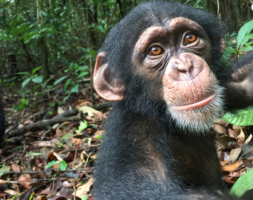5 Things We Need to Stop Telling Ourselves About Zoos

We hear a lot of things to justify keeping animals in captivity. But are these justifications based on fact, or are they simply what zoos would have us believe? Here are five things we hear about zoos, and why we should think twice about them.
Myth 1: Zoos exist for conservation

While some zoos may contribute in small ways to conservation projects, the vast majority of animal species in zoos are not on the endangered list, and the ones who are will likely never be rehabilitated to their natural habitat. A study conducted by Captive Animal Protection Society (CAPS) found that almost half of the animals in breeding programs in the EU were not even endangered in the wild.
The truth is that zoos exist primarily for profit. One of the biggest draw cards for zoos is baby animals. Babies will often be bred even when there isn’t enough room to keep them, inevitably resulting in “surplus” animals. Surplus management strategies are one of the best-kept secrets of modern zoos. In 2014, the world reacted with shock and outrage when a healthy two-year-old giraffe named Marius was killed and cut up in front of spectators at Copenhagen Zoo. His body was then fed to the lions.
In response to widespread criticism, Copenhagen Zoo’s Scientific Director Bengt Holst defended the decision, saying that the zoo had a surplus of giraffes and that this is something that’s “done every day,” just not in the public eye. Just a short time later, Copenhagen Zoo was in the news again for killing four healthy lions to make room for a new male lion they wanted to breed. The relevant zoo standards in Australia would allow a similar judgement to be made about ‘surplus animals’ here, but these “management” decisions are rarely made public.
Zoos also routinely trade and relocate animals who they deem to have outlived profitability or who no longer fit into breeding schemes. Trading animals with other zoos can be extremely stressful for the animals who are relocated, as they leave behind social bonds and surroundings they have grown accustomed to.
Just like SeaWorld and other marine parks, for zoos the interests of animals usually comes second to attracting visitors and making money.
Fact: Zoos exist for profit.
Much to their (zoo’s) embarrassment, death is a constitutive part of life, something they produce not only accidentally … but at the very core of their functioning. Dr Matthew Chrulew, Curtin University academic and zoo expert
Myth 2: Zoos are the best way to learn about animals

A zoo can teach you a lot about how animals behave in captivity but will teach you very little about the behavior of animals in the wild. Even though most modern zoos make efforts to offer animals a more natural environment, most captive animals are unable to live in a way that they would naturally and some may even be on medication to alter their behavior.
Perhaps those who visit zoos recognise this. A study of visitor behaviour at four zoos in the U.S. found that only six percent of visitors said they go to a zoo to learn more about animals, while 86 percent of visitors said they went to the zoo for “social or recreational purposes.”
In the early days of zoo popularity, television was far from an everyday reality for people. Today, with enlightening and informative nature documentaries, interactive online educational tools and the increasing ease and affordability of international travel, we have the opportunity to learn about animals by viewing them in their natural habitat.
“Learning” about animals by keeping them locked up is not only ineffective, it is obsolete.
Fact: The best way to learn about animals is in their natural habitat.
Myth 3: Zoos are a ‘normal’ part of society

There is nothing natural about a penguin, giraffe or elephant living in the middle of an Australian city. We’ve come to accept this as part of normal society. It’s only when things go wrong that we’re reminded that a city zoo is no place for an animal.
Just this year, a flood in Georgia destroyed enclosures at the Tbilisi Zoo and saw dozens of zoo animals unleashed on the streets, including lions, bears, wolves and a hippo.
The flood in Tbilisi saw zoo enclosures destroyed and animals loosed onto the streets.
Some 20 wolves, eight lions, white tigers, tigers, jackals, jaguars have either been shot dead by special forces or are missing. Mzia Sharashidze, Tbilisi Zoo spokeswoman
If we look back in history we see that keeping animals in captivity has left a trail of disasters …
- 2015: Keepers at Duisburg Zoo in Germany shot dead a male orangutan who tried to escape, saying that a sedative would have taken too long to take effect.
- 2015: Dozens of animals — including lions, tigers, monkeys and crocodiles — died from hunger or thirst at the Khan Younis Zoo in the Gaza Strip when they were left without care during the Palestinian and Israeli conflict.
- 2012: A polar bear in Buenes Aires Zoo overheated and died. (Another heat-stressed and depressed polar bear named Arturo is currently held at an Argentinian zoo and, despite public pressure, the zoo Director has refused to have him relocated.)
- 2008: A leaked memo revealed that a zookeeper at Melbourne Zoo had stabbed an elephant, Dokkoon, more than a dozen times with a sharp metal spike. The same memo exposed that a male gorilla, Rigo, had been kept in isolation for 16 years and four seals suffered partial blindness from the chlorine in the tiny pool they were kept in for up to three years while a $20 million dollar enclosure was built.
- 2007: A kangaroo was euthanised after being hit by a train that runs through the Cleveland Zoo.
- 2004: A 13-year-old male gorilla, Jabari, escaped from Dallas Zoo and was shot and killed by police.
- 2002: Flooding enclosures in Prague Zoo led to an elephant and hippopotamus being euthanised to ‘save’ them from drowning.
- 2000: An 18-year-old sloth bear named Medusa died of dehydration when Toledo Zoo officials locked her in a den to hibernate, not knowing that her species does not hibernate.
We have been born into a society that accepts zoos as commonplace but the invention of the zoo dates back thousands of years — to an era when people who looked different were also put on display. We now have unlimited options for entertainment, not to mention a greater understanding of animal sentience and needs. In today’s society, ogling at animals behind glass seems crudely outdated. Certainly it’s unnecessary and rarely (if ever) in the animals’ best interests.
Costa Rica has recognized this and in 2013 declared that it would be closing all its zoos and releasing the animals who are able to be rehabilitated to the wild. (The others would be cared for in sanctuaries or live out their lives in nature parks.) Which will be the next country to make this compassionate decision?
Fact: There is nothing “normal” about zoos. Wild animals belong in the wild, not captive in cities.
The only creature on earth whose natural habitat is a zoo is the zookeeper. Robert Brault
Myth 4: Animals in zoos are happy

Animals in captivity across the globe have been documented displaying signs of anxiety and depression. In fact, psychological distress in zoo animals is so common that it has its own name: Zoochosis.
Zoochosis can include rocking, swaying, excessively pacing back and forth, circling, twisting of the neck, self-mutilation, excessive grooming, biting, vomiting and copraphagia (consuming excrement).
These traits are largely uncommon amongst healthy and happy animals in the wild. When kept in captivity, animals are deprived of the ability to express their natural desires and the effect this can often have on their mental and emotional health is tragically clear in the form of zoochosis. Such behavior, when exhibited by confined or disturbed animals in other situations, is often referred to as “stereotypic” behavior and is recognised by scientists as a clear indicator of severe animal welfare issues.
What’s even sadder, is that to counter these problems, zoos internationally have been known to give drugs to affected animals. In her book Animal Madness, Laurel Braitman says that the practice of putting animals on anti-depressants is surprisingly common. ”At every zoo where I spoke to someone, a psychopharmaceutical had been tried.” One case Braitman shares is of a polar bear named Gus who lived at Central Park Zoo. Gus began compulsively swimming figure eights in his pool for up to 12 hours per day.
An animal psychologist determined that Gus was bored. And not surprisingly, given that his enclosure was less than 0.00009 percent of what his range in the Arctic would be. Despite being born in captivity, he would still have felt predatory impulses. In fact, when he was first moved to the zoo, he would entertain himself by stalking small children. But the zoo did not want children getting frightened so they built a barrier to stop this.
Gus was given thousands of dollars worth of behavioral therapy, the nickname “bipolar bear” and … a prescription of Prozac. His compulsive swimming eased off but never really went away. Gus died in captivity in 2013 at age 27.
Similarly, it has been revealed that SeaWorld trainers give psychoactive drugs and anti-depressants to some of its marine animals. Since the “Blackfish” documentary exposed the truth about keeping highly active and social animals like orcas in captivity, SeaWorld has seen a significant decline in attendance. Society is recognising that there’s nothing fun about sad animals.
FACT: Living in captivity has been found to lead some animals to neurosis and depression.
Myth 5: Zoos care

Humans have a great capacity for kindness towards our fellow species. When we see an animal suffer, we jump to their aid, (just like the awesome humans in this video did).
If zoos had the best interests of animals at heart, would they keep them in captivity at all? And if we as individuals have the best interests of animals at heart, will we continue to pay money to see them behind bars and glass walls?
We have the choice to show our respect for animals by letting them live a natural life, rather than contributing to an institution that breeds them for a life in captivity. You can make a difference in the lives of animals, by choosing animal-friendly alternatives to zoos, such as admiring animals in the wild, at sanctuaries or on television.
See something, Say something. Bookmark, share and help further build our directory ofAnimal Rescue Hotlines and let’s be prepared to help animals today!
Source: One Green Planet – http://www.onegreenplanet.org/animalsandnature/things-we-need-to-stop-telling-ourselves-about-zoos/

 Español
Español
 Português
Português








